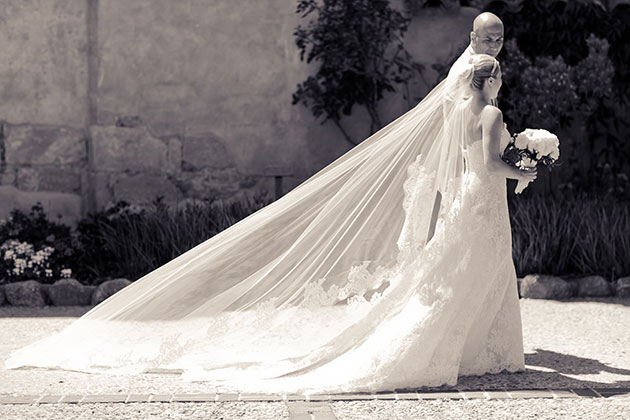
Photo: Allyson Magda Photography
They say a veil is what turns a woman in a beautiful white dress into a bride, and we agree! There’s something so romantic about the flowing fabric and the time-honored tradition, whether it’s a birdcage style or cathedral-length and edged in lace. But, er, when are you supposed to put your veil on, exactly? And do you wear your veil at the reception? We’ve got you covered. If you’ve decided to top off your wedding dress with a veil of any sort, here are a few things to keep in mind, straight from our experts.
When to Put Your Veil On
While you might be tempted to put your veil on as soon as you’ve stepped into your gown, think through your timeline first. If you’re getting ready within walking distance of your first look, ask your hairstylist to put your veil on just before you leave the room so that it’s secure and in place, but not in your way for final touch-ups as you’re getting ready to go. Getting in the car to get to the church? You may want to wait to have your veil put on until you’ve arrived, so you don’t risk wrinkling it or pulling it out as you get in and out of the vehicle (which could also mess up your hairstyle!).
When to Take Your Veil Off
Taking off your veil is totally up to you. Some brides, especially those wearing longer veils, opt to take their veils off after the ceremony and once pictures are done, so they have a little more ease of movement during cocktail hour and the reception. Others swap the longer style for a short blusher so they can maintain their bridal look without risking having their veil stepped on while dancing. If you’re wearing a blusher over your face during the ceremony, look into two-piece veils, where the blusher and the longer veil are separate, and have the longer piece removed while leaving the blusher in place.
How to Keep Your Veil in Place
While the comb attached to a veil can be fairly secure, the last thing you want is your veil blowing off mid-ceremony! Instead, after your veil is positioned correctly, grab a few bobby pins that match your hair color. Gently use the pins to further attach your veil to your hair, making sure that the pins are hidden beneath your hair. One or two pins on either side (criss-crossed for extra grip!) should do it.
Who Should Help You Remove Your Veil
Though your hairstylist would be the best person to have remove your veil after the ceremony, asking him or her to stick around for an hour or two after they’re done styling might not be possible (and could cost you extra!). Instead, either have your wedding planner help you remove your veil, or have your stylist teach your mom or maid of honor the best way to remove your veil without disrupting your ‘do.
Once they’ve gently removed any pins holding the comb in place, whoever is removing your veil should place one hand beneath your veil and on top of the comb, holding your hair in place so the comb doesn’t pull everything out. Then, with the other hand, they should start to gently pull the comb up. Once it has released a little bit, with their hand still maintaining slight pressure on your hairstyle, they should gently pull the comb out of your hair and away from your head, tilting the comb away from your head so that when the ends of the teeth are pulled out, the comb is at a 90-degree angle to the back of your head.
See more: Don’t Want a Veil? Try These Alternative Bridal Hair Accessories
